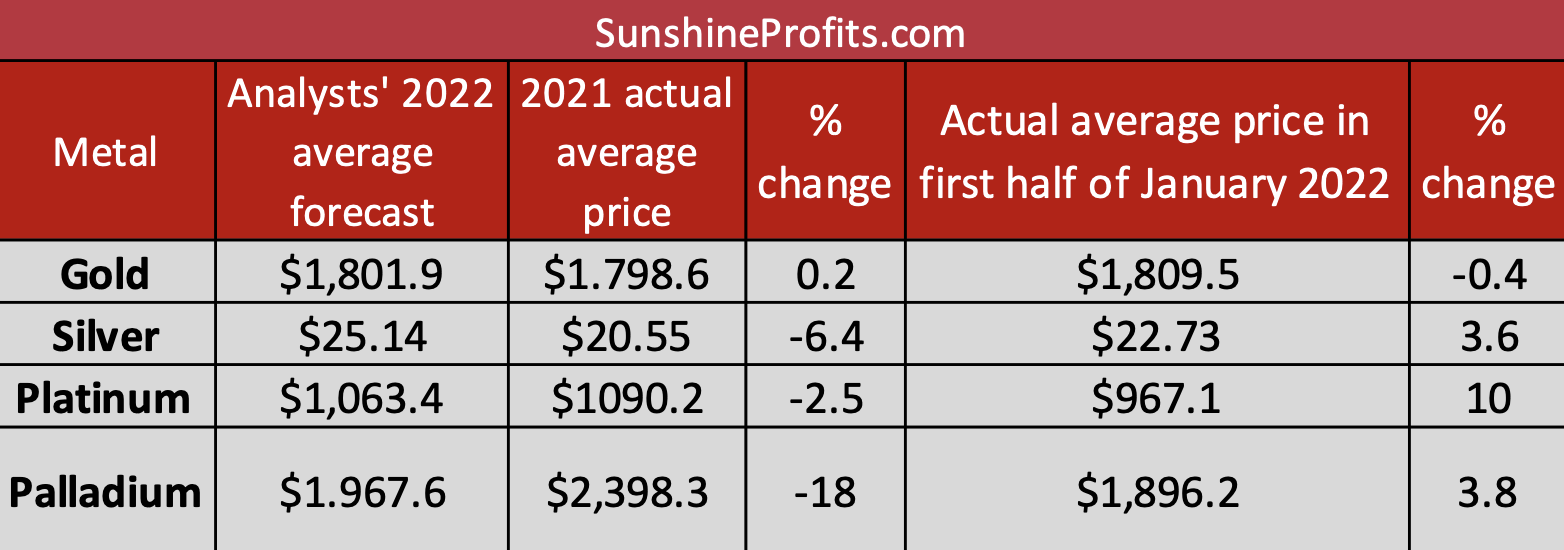Analysts' 2022 forecasts for the gold market are not overwhelmingly enthusiastic–they see it flat. However, maybe the opposite should be expected.
The LBMA has recently published its annual precious metals forecast survey. In general, the report is neutral about gold in 2022. On average, the analysts forecast gold prices to be broadly flat this year compared to the year. The average gold price in 2021 was $1,799, and it is expected to rise merely $3 to $1,802. How boring! However, as the table below shows, the forecasts for other precious metals are much more bearish, especially for palladium.

The headline numbers are the averages of 34 analysts’ forecasts. The greatest bears see the average price of gold as low as $1.630, while the lowest low – at $1,500. Meanwhile, the biggest bulls expect the average price of gold to be $1,965, while the highest high is expected to be $2.280.
The three most important drivers of precious metals prices’ performance this year are the Fed’s monetary policy, inflation, and equity market performance. This is a huge change compared to last year when analysts considered geopolitical factors, the impact of the COVID-19 pandemic, and the pace of economic recovery to be much more important. I agree this time, of course, as I always believed that macroeconomic factors are more relevant to the long-term trend in the gold market than geopolitical drivers.
Generally, the pick-up in inflation, which will keep real interest rates in negative territory, is seen as a tailwind for gold. Some analysts also expect the greenback to depreciate as the global economic recovery gathers steam, which would also be supportive of gold prices. Meanwhile, the normalization of monetary policy is considered the greatest headwind for the yellow metal, as the Fed’s tightening cycle will raise the opportunity cost of holding gold.
However, the markets have probably already priced the interest rate hikes in, so gold doesn’t have to suffer during the tightening cycle. Last time, the price of gold began to rise after the liftoff of the federal funds rate. The analysts surveyed by the LBMA also doubt the central banks’ ability to raise interest rates as high as needed to crush inflation. Instead, they are expected to stay behind the inflation curve. This is because the forecasted tightening cycle could be too difficult for the asset market and indebted economy to stomach, so it will be moderate and short-lived, just like last time.
Implications for Gold
What does the LBMA annual forecast survey predict for the yellow metal?
The report is neutral, probably because gold remains under the influence of opposite forces, which makes forecasting really challenging this year. Gold has been recently in a sideways trend, so it’s somewhat natural to expect simply more of the same, i.e., the flat market. Actually, the pundits always forecast more of the same. For example, the previous edition of the survey was bullish, as 2020 was a great year for gold. Thus, the analysts’ 2021 average forecast for the price of gold was $1,973.8, almost $200 above the actual level. Hence, please take the survey with a pinch of salt.
OK, the analysts don’t predict a literally flat market. The forecasts concerned averages, but some experts see the first half of the year as more bullish than the second, while others, vice versa. I’d rather include myself in the latter group, as my view is that the expectations of Fed tightening will continue to exert downward pressure on gold prices in the coming weeks.
However, the hawkish expectations have probably gone a little too far. At some point this year, they will be adjusted, as it becomes clear that the Fed will be forced to reduce the pace of its tightening or even reverse its stance in order to calm the market and avoid the next economic crisis. Such an adjustment will be positive for gold prices, especially since it might occur amid still high inflation, but gold bulls should remember that there is still a long way to go before that happens.
